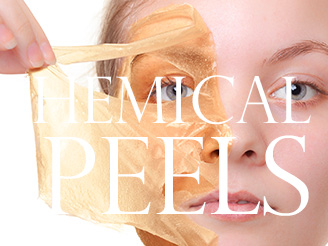 Chemical Peels
Chemical Peels
A chemical peel is a body treatment technique used to improve and smooth the texture of the skin, often facial skin, using a chemical solution that causes the dead skin to slough off and eventually peel off.The regenerated skin is usually smoother and less wrinkled than the old skin. Some types of chemical peels can be purchased and administered without a medical license, however people are advised to seek professional help from a dermatologist, esthetician, plastic surgeon, oral and maxillofacial surgeon, or otolaryngologist on a specific type of chemical peel before a procedure is performed.
There are several types of chemical peels.
Alpha hydroxy acid peels.- Alpha hydroxy acids (AHAs) are naturally occurring carboxylic acids such as glycolic acid, a natural constituent of sugar cane juice and lactic acid, found in sour milk and tomato juice. This is the mildest of the peel formulas and produces light peels for treatment of fine wrinkles, areas of dryness, uneven pigmentation and acne. Alpha hydroxy acids can also be mixed with a facial wash or cream in lesser concentrations as part of a daily skin-care regimen to improve the skin’s texture.
There are five usual fruit acids: citric acid, glycolic acid, lactic acid, malic acid and tartaric acid. Many other alpha hydroxy acids exist and are used.
AHA peels are not indicated for treating wrinkles.
AHA peels may cause stinging, skin redness, mild skin irritation, and dryness.
Beta hydroxy acid peels.- It is becoming common for beta hydroxy acid (BHA) peels to be used instead of the stronger alpha hydroxy acid (AHA) peels due to BHA’s ability to get deeper into the pore than AHA[citation needed]. Studies show that BHA peels control sebum excretion, acne as well as remove dead skin cells to a certain extent better than AHAs[citation needed] due to AHAs only working on the surface of the skin. Salicylic acid is a beta hydroxy acid.
Jessner’s peel.- Jessner’s peel solution, formerly known as the Coombe’s formula, was pioneered by DMax Jessner, a German-American dermatologist. Jessner combined 14% salicylic acid, lactic acid, and resorcinol in an ethanol base. It is thought to break intracellular bridges between keratinocytes.[citation needed] It is very difficult to “overpeel” the skin due to the mild percentages associated with the acid combination, and does not penetrate as deeply as other chemical peels.
Retinoic acid peel.- Retinoic acid is a retinoid. This type of facial peel is also performed in the office of a plastic surgeon, oral and maxillofacial surgeon, or a dermatologist in a medical spa setting. This is a deeper peel than the beta hydroxy acid peel and is used to remove scars as well as wrinkles and pigmentation problems. It is usually performed in conjunction with a Jessner; which is performed right before, in order to open up the skin, so the retinoic acid can penetrate on a deeper level. The client leaves with the chemical peel solution on their face. The peeling process takes place on the third day. More dramatic changes to the skin require multiple peels over time.
Croton oil / phenol peel.- Formerly known as a phenol peel, this skin treatment was re-popularized by Gregory Hetter. In a series of articles, he covers its historical use on a clandestine basis by early Hollywood stars in the 1920s to maintain their youthful appearance, to its early incorporation into rejuvenating medical practice in the 1960s by Thomas Baker, all the way to developing a modern basis for its use and dosage. Briefly, the active ingredient is clearly the croton oil component, which previously was poorly understood or deliberately obfuscated. It is the basis for a deep chemical peel, which causes an intense caustic exfoliating reaction in the skin, and eventually results in regeneration of the dermal architecture, effectively restoring younger dermis in a way that cannot be replicated by other, more superficial peels.
